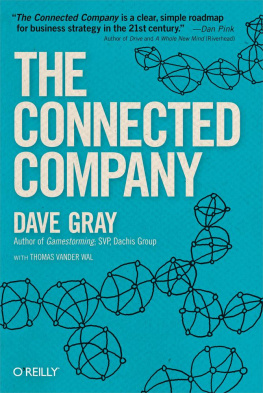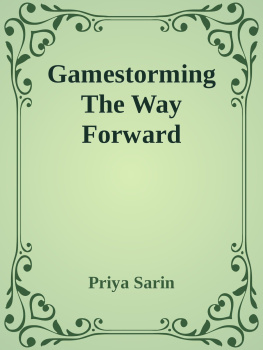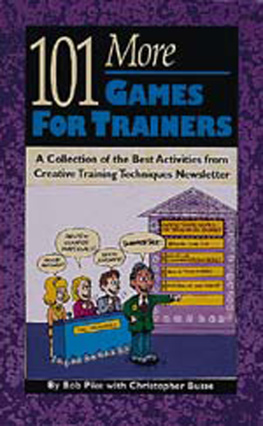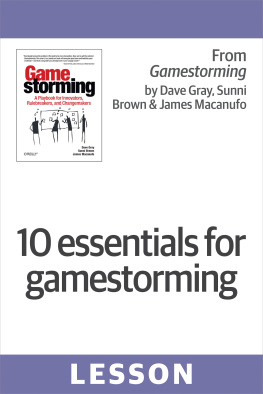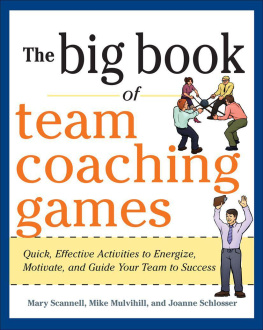Appendix A. Acknowledgements
Thanks are due to so many: Richard Saul Wurman for his inspiration and encouragement; David Sibbet, Alex Osterwalder, Chris Messina, and Luke Hohmann for their pioneering work, and for the design of some amazing games, and for agreeing to share them in this book; Nancy Duarte, Garr Reynolds, and Dan Roam for setting an example for us all to follow; Aric Wood, for believing in the project and many conversations along the way; Bob Logan, Alex Wright, and Jo Guldi for their help, deep knowledge, and scholarship; Michael Dila and Robin Uchida for demonstrating innovation by example; Richard Black, Lee Weldon, Louis Kim, and Stuart Curley for their assistance in the long development of the concepts, Karl Gude for just being himself; Colleen Wheeler for thoughtful and considerate editing, and for the countless hours herding cats and keeping the project on track; Brynn Evans, Toby Daniels, Marcel Botha, and all the other Overlappers for helping to test the viability and for their inspiring work on the Betacup; Liz Danzico, Andy Budd, Peter Merholz, Bill DeRouchey, and Lenore Richards for helping get Gamestorming off the ground; the entire UX community, which helped to guide the project through its early stages; Tim O'Reilly for making all of this possible; Edie Freedman for design leadership and shepherding the project through the design process; Isaac Milla and Alyssa Beavers for their patient understanding during the long hours it took to get the project completed; and most of all, thank you to Michelle Milla, my support, my love, my companion through thick and thin.
Dave Gray
I typically like to take personal credit for my successes, but in most cases that's just delusion. The truth is that all of lifesuccess, failure, triumph, and sorrowis intricately linked to the people around us. I thank them not only for their love and (often undeserving) support, but also for the hard lessons they've taught me over the years. So these acknowledgements are to my people, in no particular order. Rocky: You are, hands down, the most awesome brother on the planet. I am so thankful for the experiences we've had together. I love you and I wouldn't be half the person I am today without you. Joe: Thank you for taking on three children when it must have felt like adopting barnyard animals. I love you and am so impressed by your fortitude and your ability to remember the punchline to every joke. "I'm glad you got to see me." Christy: I know no one with your compassion and your strength. I love you with all of my heart and I am so thankful that I can have many more years as your little sister. Cassie: You are the twinkle in everyone's eye. Thank you for your heart of gold, your incredible talents, and for thinking that Aunt Sunni is so cool. I'll be with you every step of the way through life's journey. I love you to pieces. Shannon: Guess what? Gorgeous blondes with mermaid-like hair are BADASS. Thank you for reminding me to stop making things black and white and start paying attention to the beauty and possibility in the world. Chet: You are so patient with me; I've grown light years just by being with you. I thank you for the love, the enlightenment, and the sex. Now please try to actually absorb that compliment. Aunt Marilyn: You are amazing. You continue to learn and grow and to share your wisdom with me. I love you and I thank my lucky stars that you are my aunt. Fran: Your son is amazingnice work. Thank you for him and also for the invaluable lesson that I can enjoy life as long as I choose to. Marilyn Martin: I made it through the first few months of my entrepreneurial venture because you took a chance on me. I will always be thankful. David Sibbet: You were among the first to put visual thinking in the workplace. Thank you, too, for taking a chance on a total stranger and for giving me an opportunity to make a career out of something I love. And to all of the visual practitioners in the world. You're ahead of your time and your work is a source of constant inspiration. Long live the visual thinking revolution!
Sunni Brown
I owe an immeasurable debt to my clients and coworkers at XPLANE, who pioneer these techniques in the real world while playing with live ammunition. This book is as much about them as for them. I'm continually grateful for their courage and enthusiasm in charting out new and uncertain territory. The techniques here are a snapshot of living, often informal, knowledge in use at any given whiteboard at any given moment around the world. In that sense, creating this book would not have been possible without the candid and open collaboration of a community of practitioners, who have helped point us to original sources, compiled research, and contributed their own games to the mix. In every case we have done our best to give credit where it is due, and I apologize in advance if we have not explicitly recognized someone's contribution. In particular, thanks to Luke Hohmann, author of Innovation Games , whose coaching and expertise has been invaluable. And to Scott Matthews of XPLANE, whose original "big head" doodle would become the first empathy map. I may be most indebted to my wife, Elizabeth, who continues to indulge my sense of amusement on most things and whose key value-add in this engagement included managing the scope of consultant jargon in my deliverables. Thanks for that.
James Macanufo
About the Authors
Dave Gray is the Founder and Chairman of XPLANE, the visual thinking company. Founded in 1993, XPLANE has grown to be the world's leading consulting and design firm focused on information-driven communications. Dave's time is spent researching and writing on visual business, as well as speaking, coaching and delivering workshops to educators, corporate clients and the public.He is also a founding member of VizThink, an international community of Visual Thinkers.
Sunni Brown, M.P.A., is Owner of BrightSpot Info Design, a company specializing in visual thinking to support organizational and group success. Sunni was trained in graphic facilitation at The Grove Consultants International, a San Francisco-based company that pioneered the use of visuals in meetings and group processes. She is currently an Associate of The Grove, a freelance consultant for XPlane - the visual thinking company - and an Associate of Alphachimp Studios. She is also co-Founder of VizThink Austin, currently the largest visual thinking community in the United States. Sunni presents regularly on the topics of graphic facilitation, graphic recording and visual thinking. She is also a contributing researcher for Nancy Duarte's upcoming book on storytelling and presentations. Sunni holds Bachelor's degrees in Journalism and Linguistics and a Master's in Public Affairs from the Lyndon Baines Johnson School of Public Affairs. She lives in Austin, TX.
James Macanufo: As a consultant at XPLANE, James helps largetechnology and government clients develop their vision, strategy andcommunication plans. He actively obsessed with understanding whatthings are, the way they work, and why they matter. He is also anactive gamer and occasional inventor of card games.
Chapter 1. What Is a Game?
GAMES AND PLAY ARE NOT THE SAME THING .
Imagine a boy playing with a ball. He kicks the ball against a wall, and the ball bounces back to him. He stops the ball with his foot and kicks it again. By engaging in this kind of play, the boy learns to associate certain movements of his body with the movements of the ball in space. We could call this associative play .
Now imagine that the boy is waiting for a friend. The friend appears, and the two boys begin to walk down a sidewalk together, kicking the ball back and forth as they go. Now the play has gained a social dimension; one boy's actions suggest a response, and vice versa. You could think of this form of play as a kind of improvised conversation, where the two boys engage each other using the ball as a medium. This kind of play has no clear beginning or end; rather, it flows seamlessly from one state into another. We could call this


